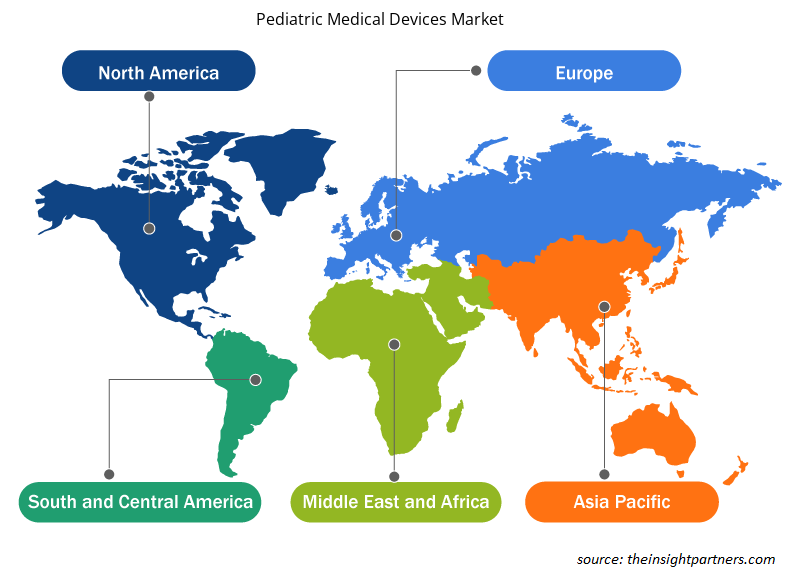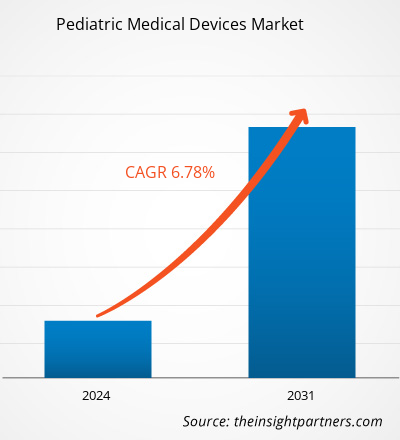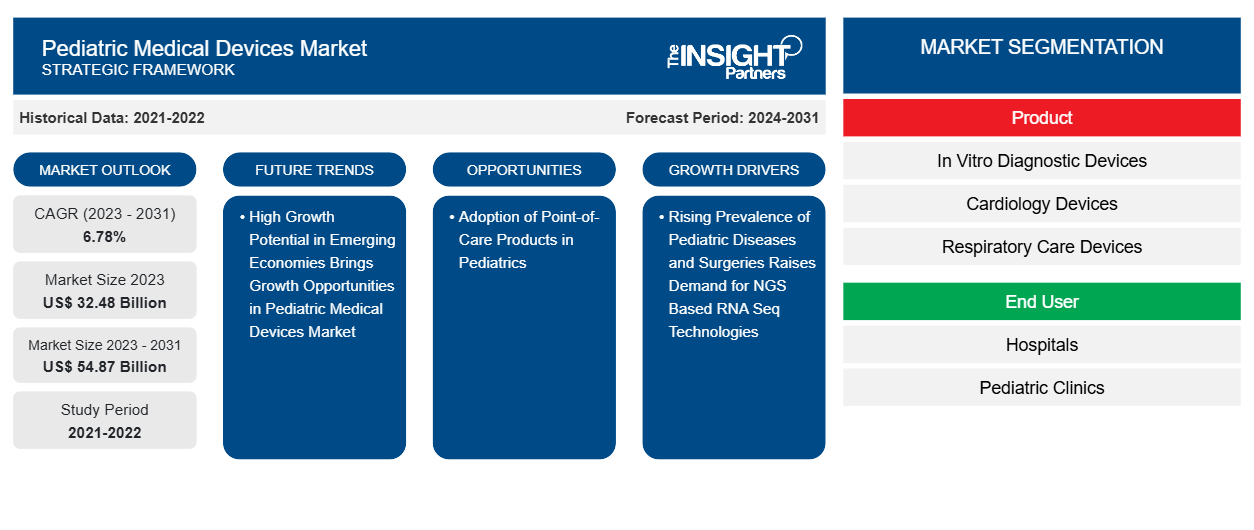Der Markt für pädiatrische Medizingeräte soll von 32,48 Milliarden US-Dollar im Jahr 2023 auf 54,87 Milliarden US-Dollar im Jahr 2031 anwachsen. Der Markt wird zwischen 2023 und 2031 voraussichtlich eine durchschnittliche jährliche Wachstumsrate von 6,78 % verzeichnen. Die steigende Beliebtheit von Point-of-Care-Geräten für die Kinderpflege dürfte weiterhin ein wichtiger Trend auf dem Markt bleiben.
Marktanalyse für pädiatrische Medizinprodukte
Pädiatrische Medizinprodukte behandeln oder diagnostizieren Erkrankungen bei Personen von der Geburt bis zum Alter von 21 Jahren. Als pädiatrische Patienten gelten Personen, die zum Zeitpunkt ihrer Diagnose oder Behandlung 21 Jahre oder jünger sind . Pädiatrische Subpopulationen werden in Neugeborene (Geburt bis 28 Tage), Säuglinge (29 Tage bis unter 2 Jahre), Kinder (2 Jahre bis unter 12 Jahre) und Jugendliche (12 bis 21 Jahre) eingeteilt. Die zunehmende Zahl chronischer Erkrankungen bei der pädiatrischen Bevölkerung steigert die Nachfrage nach pädiatrischen Medizinprodukten.
Marktübersicht für pädiatrische Medizinprodukte
Laut einem im August 2020 in der Wiley Online-Bibliothek veröffentlichten Artikel werden in den USA jährlich 3,9 Millionen Operationen an Kindern im Alter von 0 bis 17 Jahren durchgeführt. Die häufigsten chirurgischen Eingriffe im Kindesalter, Beschneidungen ausgenommen, betreffen den Bereich von Ohren, Nase und Rachen: Mandel- und Adenoidektomien sowie das Einsetzen von Paukenröhrchen. Die steigende Zahl von Operationen bei Kindern erhöht die Nachfrage nach neuen Innovationen auf dem Markt für pädiatrische Medizinprodukte. Darüber hinaus führen Unternehmen mit der wachsenden Nachfrage neue Technologien ein, um das Wachstum ihres Marktanteils zu beschleunigen. So brachte Preceptis Medical, Inc. im Juni 2021 das Hummingbird Tympanostomy Tube System (TTS) auf den Markt, ein Paukenröhrchensystem der nächsten Generation für ambulante Myringotomie-Eingriffe bei Kindern. Das neue Hummingbird-Gerät verfügt über ein verbessertes ergonomisches Design, das Tympanostomie-Eingriffe bei Kleinkindern ohne Vollnarkose erfolgreicher macht.
Passen Sie diesen Bericht Ihren Anforderungen an
Sie erhalten kostenlos individuelle Anpassungen an jedem Bericht, einschließlich Teilen dieses Berichts oder einer Analyse auf Länderebene, eines Excel-Datenpakets sowie tolle Angebote und Rabatte für Start-ups und Universitäten.
-
Holen Sie sich die wichtigsten Markttrends aus diesem Bericht.Dieses KOSTENLOSE Beispiel umfasst eine Datenanalyse von Markttrends bis hin zu Schätzungen und Prognosen.
Treiber und Chancen auf dem Markt für pädiatrische Medizinprodukte
Steigende Zahl von Kinderoperationen begünstigt den Markt
Wie das Kinderhilfswerk der Vereinten Nationen (UNICEF) betont, ist Lungenentzündung die häufigste Todesursache bei Kindern unter 5 Jahren und verursacht jährlich ca. 700.000 Todesfälle. Die zunehmende Verbreitung chronischer Krankheiten, darunter Atemwegserkrankungen, Krebs und Herz-Kreislauf-Erkrankungen, dürfte die Nachfrage nach pädiatrischen Medizinprodukten steigern. Hypoxisch-ischämische Enzephalopathie (HIE) ist eine der Hauptursachen für Mortalität und Morbidität bei Neugeborenen und Neugeborenen, die kurz vor der Entbindung stehen. Mit den Fortschritten in der Neugeborenenpflege haben medizinische Technologien die Einführung neuer Therapien zur Unterstützung der Pflege oder zur Erprobung in großen klinischen Studien ermöglicht. Infolgedessen treibt die zunehmende Einführung medizinischer Geräte in pädiatrischen Pflegeeinrichtungen den globalen Markt für pädiatrische Medizinprodukte an.Hypoxic-Ischemic Encephalopathy (HIE) is a leading cause of neonatal mortality and morbidity in term and near-term infants. With the advancements in neonatal care,
Hohes Wachstumspotenzial in Schwellenländern bietet Wachstumschancen
Laut einem im November 2022 in BMJ Open veröffentlichten Artikel kam eine Studie, die Daten aus demografischen und gesundheitlichen Erhebungen aus 33 Ländern Subsahara-Afrikas verwendete, zu dem Schluss, dass häufige Kinderkrankheiten bei Kindern unter 5 Jahren in Ländern Subsahara-Afrikas weit verbreitet sind. Faktoren auf individueller und gemeinschaftlicher Ebene sind mit diesem Problem verbunden. Darüber hinaus bieten die wachsende Gesundheitsinfrastruktur in Schwellenländern und die zunehmende Bedeutung der Telemedizin vielversprechende Aussichten für eine Marktexpansion. So stärken gemeinsame Initiativen internationaler Organisationen wie der WHO und UNICEF in Regionen wie dem Asien-Pazifik-Raum sowie dem Nahen Osten und Afrika ihre pädiatrische Gesundheitsinfrastruktur, indem sie ein Bewusstsein für die Sicherheit von Kindern schaffen. Diese dürften im Prognosezeitraum lukrative Möglichkeiten für das Wachstum des Marktes für pädiatrische Medizinprodukte bieten.BMJ Open in November 2022, a study conducted using Demographic and Health Survey data from 33 sub-Saharan African countries concluded that Common childhood illnesses are prevalent among under-5 children in sub-Saharan African countries. Factors at individual and community levels are associated with this issue. Furthermore, the expanding healthcare infrastructure in emerging economies and the growing emphasis on telemedicine offer promising prospects for market expansion. Thus, collective initiatives by the international organizations, such as WHO and UNICEF in the regions such as the Asia Pacific, and Middle East and Africa strengthen their pediatric healthcare infrastructures by creating awareness regarding pediatric safety. These are likely to offer lucrative opportunities for the pediatric medical devices market growth during the forecast period.
Segmentierungsanalyse des Marktberichts für pädiatrische Medizingeräte
Wichtige Segmente, die zur Ableitung der Marktanalyse für pädiatrische medizinische Geräte beigetragen haben, sind Produkt und Endbenutzer.
- Der Markt für pädiatrische Medizinprodukte ist nach Produkt segmentiert in In-vitro-Diagnostikgeräte (IVD), Kardiologiegeräte, Beatmungsgeräte, Überwachungsgeräte, Geräte für die Intensivstation für Neugeborene und andere. Das Segment der In-vitro-Diagnostikgeräte (IVD) hatte im Jahr 2023 den größten Marktanteil.vitro diagnostic (IVD) devices, cardiology devices, respiratory care devices, monitoring devices, neonatal ICU devices, and others. The in vitro diagnostic (IVD) devices segment held the largest market share in 2023.
- Nach Endverbraucher ist der Markt in Krankenhäuser, Kinderkliniken und andere segmentiert. Das Krankenhaussegment hielt im Jahr 2023 den größten Marktanteil.
Marktanteilsanalyse für pädiatrische Medizingeräte nach Geografie
Der geografische Umfang des Marktberichts für pädiatrische Medizinprodukte ist hauptsächlich in fünf Regionen unterteilt: Nordamerika, Asien-Pazifik, Europa, Naher Osten und Afrika sowie Süd- und Mittelamerika. Der Asien-Pazifik-Raum wird in den kommenden Jahren voraussichtlich mit der höchsten durchschnittlichen jährlichen Wachstumsrate wachsen.CAGR in the coming years.
Der nordamerikanische Markt für pädiatrische Medizinprodukte wird anhand der drei wichtigsten Länder USA, Kanada und Mexiko analysiert. Die USA werden voraussichtlich im Jahr 2023 den größten Anteil am nordamerikanischen Markt für pädiatrische Medizinprodukte haben.
Laut der American Academy of Pediatrics haben etwa 3 bis 4 % aller in den USA geborenen Babys angeborene Fehlbildungen. Laut den Centers for Disease Control and Prevention (CDC) ist jedes Jahr 1 von 33 in den USA geborenen Babys von Geburtsfehlern betroffen. Der Anstieg der Zahl der Kinder mit Geburtsfehlern spiegelt die größere Zahl der Bevölkerungsgruppen wider, die sich chirurgischen Behandlungen unterziehen. Daher tragen Faktoren wie die zunehmende Belastung durch Kinderkrankheiten, F&E-Aktivitäten zur Entwicklung fortschrittlicher pädiatrischer Medizinprodukte und zunehmende Produkteinführungen zum Wachstum des Marktanteils pädiatrischer Medizinprodukte in den USA bei.
Regionale Einblicke in den Markt für pädiatrische Medizinprodukte
Die regionalen Trends und Faktoren, die den Markt für pädiatrische Medizinprodukte während des gesamten Prognosezeitraums beeinflussen, wurden von den Analysten von Insight Partners ausführlich erläutert. In diesem Abschnitt werden auch die Marktsegmente und die Geografie für pädiatrische Medizinprodukte in Nordamerika, Europa, im asiatisch-pazifischen Raum, im Nahen Osten und Afrika sowie in Süd- und Mittelamerika erörtert.

- Erhalten Sie regionale Daten zum Markt für pädiatrische Medizinprodukte
Umfang des Marktberichts zu pädiatrischen Medizinprodukten
| Berichtsattribut | Details |
|---|---|
| Marktgröße im Jahr 2023 | 32,48 Milliarden US-Dollar |
| Marktgröße bis 2031 | 54,87 Milliarden US-Dollar |
| Globale CAGR (2023 - 2031) | 6,78 % |
| Historische Daten | 2021-2022 |
| Prognosezeitraum | 2024–2031 |
| Abgedeckte Segmente |
Nach Produkt
|
| Abgedeckte Regionen und Länder |
Nordamerika
|
| Marktführer und wichtige Unternehmensprofile |
|
Marktteilnehmerdichte für pädiatrische Medizinprodukte: Auswirkungen auf die Geschäftsdynamik verstehen
Der Markt für pädiatrische Medizinprodukte wächst rasant. Dies wird durch die steigende Nachfrage der Endnutzer aufgrund von Faktoren wie sich entwickelnden Verbraucherpräferenzen, technologischen Fortschritten und einem größeren Bewusstsein für die Vorteile des Produkts vorangetrieben. Mit der steigenden Nachfrage erweitern Unternehmen ihr Angebot, entwickeln Innovationen, um die Bedürfnisse der Verbraucher zu erfüllen, und nutzen neue Trends, was das Marktwachstum weiter ankurbelt.
Die Marktteilnehmerdichte bezieht sich auf die Verteilung der Firmen oder Unternehmen, die in einem bestimmten Markt oder einer bestimmten Branche tätig sind. Sie gibt an, wie viele Wettbewerber (Marktteilnehmer) in einem bestimmten Marktraum im Verhältnis zu seiner Größe oder seinem gesamten Marktwert präsent sind.
Die wichtigsten auf dem Markt für pädiatrische Medizinprodukte tätigen Unternehmen sind:
- F. Hoffmann-La Roche Ltd
- Allgemeine Elektrizit?tsgesellschaft
- Atom Medical Corp.
- Koninklijke Philips NV
- Siemens AG
- Medtronic
Haftungsausschluss : Die oben aufgeführten Unternehmen sind nicht in einer bestimmten Reihenfolge aufgeführt.

- Überblick über die wichtigsten Akteure auf dem Markt für pädiatrische Medizinprodukte
Marktnachrichten und aktuelle Entwicklungen für pädiatrische Medizinprodukte
Der Markt für pädiatrische Medizinprodukte wird durch die Erhebung qualitativer und quantitativer Daten aus Primär- und Sekundärforschung bewertet, die wichtige Unternehmenspublikationen, Verbandsdaten und Datenbanken umfasst. Nachfolgend sind einige der Entwicklungen auf dem Markt für pädiatrische Medizinprodukte aufgeführt:
- OrthoPediatrics Corp. hat eine Vereinbarung zur Übernahme von Pega Medical geschlossen, einschließlich des Fassier-Duval Telescopic Intramedullary System, das für Patienten mit Osteogenesis Imperfecta und anderen Knochendeformationen entwickelt wurde. Ihr Produktangebot umfasst neuartige Technologien zur Behandlung einiger der einzigartigsten Erkrankungen in der Kinderorthopädie. (Quelle: OrthoPediatrics Corp, Pressemitteilung, Juni 2022).
- LMT Medical Systems hat den „Nomag IC Enhanced“ entwickelt, einen fortschrittlichen MR-Diagnostik-Inkubator, der es ermöglicht, Neugeborene und Frühgeborene direkt von der Neugeborenen-Intensivstation in den MR-Raum zu verlegen, um sie dort mit optimaler, nicht-invasiver Magnetresonanztomographie zu untersuchen. Während des Transports und der MRT-Untersuchung ist das Neugeborene im lebenserhaltenden, temperatur- und feuchtigkeitskontrollierten MR-Inkubator geschützt. (Quelle: Ergotron, Pressemitteilung, Dezember 2020).
Marktbericht zu pädiatrischen Medizinprodukten – Umfang und Ergebnisse
Der Bericht „Marktgröße und Prognose für pädiatrische medizinische Geräte (2021–2031)“ bietet eine detaillierte Analyse des Marktes, die die folgenden Bereiche abdeckt:
- Marktgröße und Prognose für pädiatrische Medizinprodukte auf globaler, regionaler und Länderebene für alle wichtigen Marktsegmente, die im Rahmen des Berichts abgedeckt sind
- Markttrends für pädiatrische Medizinprodukte sowie Marktdynamiken wie Treiber, Einschränkungen und wichtige Chancen
- Detaillierte PEST/Porters Five Forces- und SWOT-Analyse
- Marktanalyse für pädiatrische Medizinprodukte, die wichtige Markttrends, globale und regionale Rahmenbedingungen, wichtige Akteure, Vorschriften und aktuelle Marktentwicklungen umfasst
- Branchenlandschaft und Wettbewerbsanalyse, die die Marktkonzentration, Heatmap-Analyse, prominente Akteure und aktuelle Entwicklungen auf dem Markt für pädiatrische Medizinprodukte umfasst
- Detaillierte Firmenprofile
- Historische Analyse (2 Jahre), Basisjahr, Prognose (7 Jahre) mit CAGR
- PEST- und SWOT-Analyse
- Marktgröße Wert/Volumen – Global, Regional, Land
- Branchen- und Wettbewerbslandschaft
- Excel-Datensatz
Aktuelle Berichte
Verwandte Berichte
Erfahrungsberichte
Grund zum Kauf
- Fundierte Entscheidungsfindung
- Marktdynamik verstehen
- Wettbewerbsanalyse
- Kundeneinblicke
- Marktprognosen
- Risikominimierung
- Strategische Planung
- Investitionsbegründung
- Identifizierung neuer Märkte
- Verbesserung von Marketingstrategien
- Steigerung der Betriebseffizienz
- Anpassung an regulatorische Trends























 Kostenlose Probe anfordern für - Markt für pädiatrische Medizinprodukte
Kostenlose Probe anfordern für - Markt für pädiatrische Medizinprodukte